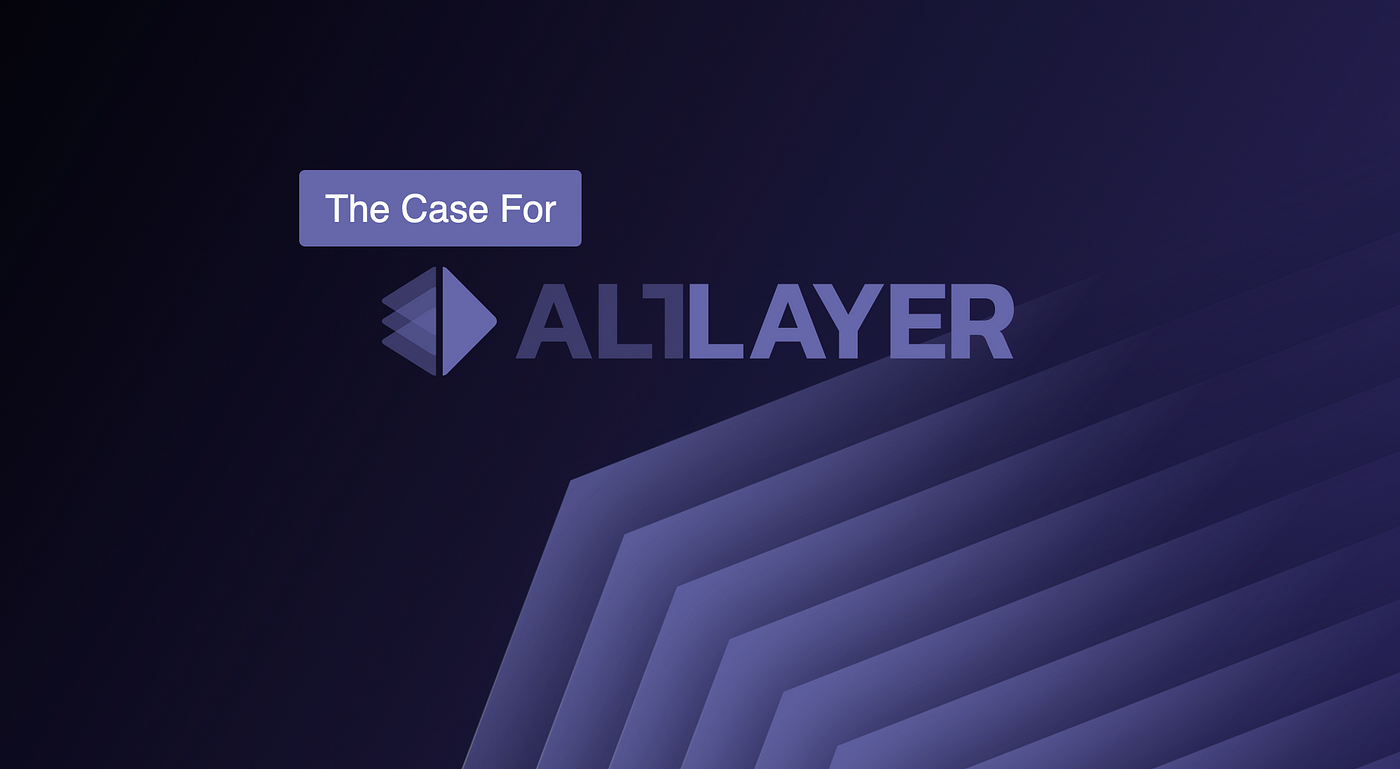
Against the backdrop of recent announcements by popular dApps to move from a general purpose chain to an app-specific chain.
在流行的dApps最近宣布从通用链转移到特定应用链的背景下,唱一唱反调。
This blogpost presents a not-so-short case for AltLayer. The content in this post is an unabridged version of a recent tweet thread from our official Twitter account and explains the rationale behind building AltLayer against the backdrop of recent announcements by popular dApps to move from a general purpose chain to an app-specific chain.
这篇博文为 AltLayer 提供了一个不那么短的案例。这篇文章中的内容是我们官方 Twitter 帐户中最近 推文 的未删节版本,也解释了在流行的 dApp 最近宣布从通用链转移到特定应用链的背景下,我们不但不敢苟同,还构建了 AltLayer 的根本原因。
-
GM #L222. We’re excited to be building at a time when popular decentralised apps have started to outgrow the platforms where they were initially launched. DefiKingdoms was the first one to move from being a dApp on a Layer 1 to having its own app chain as an Avalanche subnet.
GM #L222。 我们很高兴,能在流行的去中心化应用,开始超越最初发布的平台时开始构建。 DefiKingdoms 第一个从Layer 1上的 dApp 转变为拥有自己的应用链——作为 Avalanche 子网。
-
Yuga Labs (the entity behind CryptoPunks) soon joined the chorus when they announced that they were turning off the lights on Ethereum after their highly anticipated NFT sale faced scalability issues. They are looking to migrate the project to its own chain in order to scale. Even though the Apecoin community rejected the proposal of moving away from Ethereum, about 47% of the community still voted in favor of ApeChain.
Yuga Labs(CryptoPunks 背后的实体)很快入伙,在他们宣布备受期待的 NFT 销售面临可扩展性问题后,他们将关闭以太坊的灯(离开以太坊)。他们正在寻求将项目迁移到自己的链中来进行扩容。尽管 Apecoin 社区拒绝了离开以太坊的提议,但仍有约 47% 的社区投票支持 ApeChain。
-
And most recently, dYdX — the largest decentralised derivatives exchange on Ethereum announced that their version 4 will be built on a sovereign Layer 1 with its own set of validators using the Cosmos SDK.
最近,以太坊上最大的去中心化衍生品交易所 dYdX 宣布,他们的第 4 版将建立在主权Layer 1之上,并自己拥有一组使用 Cosmos SDK 的验证者。
-
Each one of these dApps has been extremely popular among users, traders and crypto enthusiasts. We believe that transition from a general purpose chain like Ethereum to an app-specific chain will become a norm among popular dApps that would like to provide better UX to end users.
这些 dApp 都在用户、交易者和加密爱好者中非常受欢迎。我们相信,从像以太坊这样的通用链过渡到特定应用链将成为流行 dApp 的常态,它们希望为最终用户提供更好的用户体验。
-
The main reason for building an app-chain is that Ethereum has a shared blockspace, which results in one popular dApp consuming a disproportionate share of the blockspace for itself, while users of other dApps are left with poor UX due to increased gas fees and settlement time.
构建应用链的主要原因是以太坊有一个共享的区块空间,这导致一个流行的 dApp 为自己消耗了不成比例的区块空间额度,而其他 dApp 的用户由于gas费和结算时间增加,感到体验不佳。
-
dApps like DefiKingdoms, dYdX, Yuga Labs and others exemplify the need to have app-owned blockspace. There are a few solutions in the space today that these dApps could use such as Polkadot, Avalanche and Cosmos SDK. However, each comes with its own trade-offs.
DefiKingdoms、dYdX、Yuga Labs 等 dApp 证明了应用拥有的区块空间之必要性。如今,这些 dApp 可以使用一些解决方案,例如 Polkadot、Avalanche 和 Cosmos SDK。然而,每种又都有自己的取舍。
-
For example, while some of these are completely permissionless, (i.e., Cosmos SDK), others are not so much, for example Avalanche’s subnets. Some follow a shared security model, where each chain is secured by a common set of validators (i.e., Avalanche and Polkadot).
例如,虽然其中一些是完全无许可的(即 Cosmos SDK),但其他的则并非如此,例如 Avalanche 的子网。有些遵循共享安全模型,其中每条链都由一组通用验证者(即 Avalanche 和 Polkadot)保护。
-
While others such as Cosmos SDK chains don’t natively share security and each chain has its own set of validators. Imagine a Cosmos-style app chain that is secured only by a handful of validators, where controlling ⅓ of them would allow an attacker to halt the network.
虽然像Cosmos SDK等其他链本身并不共享安全性,但每条链都有自己的一组验证者。想象一个 Cosmos 风格的应用链,它仅由少数验证者保护,控制其中的 1/3 将使得攻击者停止网络。
-
And controlling ⅔ of them would make the network produce invalid blocks. Security of an application therefore can get severely impacted if the security of the app chain is not tethered to a larger and more secure network such as a Layer 1 like Ethereum.
而控制其中的⅔会使网络产生无效块。因此,如果应用链的安全性未与更大、更安全的网络(如以太坊等layer1)绑定,则应用的安全性可能会受到严重影响。
-
Moreover, app chains can be a waste of resources (physical or economic) if the dApp does not command enough usage. For example, in the case of Avalanche, a dApp chain takes the form of a subnet that requires staking of the main chain token (i.e., $AVAX) for economic security.
此外,如果 dApp 没有获得足够的使用率,应用链可能会浪费资源(物理或经济意义)。例如,在 Avalanche 的情况下,dApp 链采用子网的形式,需要抵押主链代币(即 $AVAX)来确保经济安全。
-
Therefore a dApp that can barely consume its blockspace will end up hogging a scarce economic resource that could instead be utilised to secure a more used subnet.
因此,几乎不消耗其区块空间的 dApp 最终会占用稀缺的经济资源,而这些资源可以用来保护使用更频繁的子网。
-
On the one hand, in case of general purpose chains (like Ethereum), more used dApps compete for blockspace with a large number of less used dApps. While on the other hand, each dApp having its own chain becomes a waste of resources.
一方面,在通用链(如以太坊)的情况下,频繁使用的 dApp与大量非高频使用的 dApp 竞争区块空间。而另一方面,每个拥有自己链的 dApp 都会浪费资源。
-
Ergo, there is a need to design an architecture that offers the best of both worlds as existing approaches and solutions present two opposite extremes.
因此,现有方法和解决方案呈现出两个相反的极端,故而需要设计一种能够两全其美的架构。
-
Another key point to note is that there are popular dApps that do not need a dedicated blockspace for eternity but rather only for a short period of time when the demand is expected to shoot up. For instance, the Yuga Labs case that involves NFT minting was a short-lived event.
另一个需要注意的关键点是,有些流行的 dApp 不需要永久专用的区块空间,而只需要在预期需求激增的短时间内(保证区块空间使用)即可。例如,涉及 NFT 铸币的 Yuga Labs 案例就是一个短暂的活动。
-
In fact, most NFT mint events are over in a few days (very often in hours or even minutes) and it’s only during that period that the user activity is extremely high and there is a need for an elastic scaling solution.
事实上,大多数 NFT 铸币事件在几天内就结束了(通常是几小时甚至几分钟),只有在这期间用户活动非常高,需要弹性扩展解决方案。
-
As soon as the mint event is over, the user activity slows down quite quickly to a point where the generated transaction volume from secondary trading or other activities can be easily handled by any legacy chain.
铸币事件一结束,用户活动就会很快减慢到任何单片链可以轻松处理的二级交易或其他活动产生的交易量。
-
It’d also be wasteful to build an app chain that won’t see much activity as soon as the mint event is over. Moreover, by setting up an app chain, the project would also get isolated from other NFT projects such as marketplaces, lending, etc., thereby breaking composability.
构建一个在铸币事件结束后,就不会看到太多活动的应用链,也是一种浪费。此外,通过建立应用链,该项目还将与市场、借贷等其他 NFT 项目隔离,从而破坏可组合性。
-
The ideal solution would be a transient execution layer secured by a Layer 1 that devs could spin up prior to the mint event, do the mint on the execution layer and once the minting is over, the assets get settled on the Layer 1 and the transient execution layer gets disposed of.
理想的解决方案是由Layer 1保护的临时执行层,开发人员可以在铸币事件之前启动,在执行层上铸币,一旦铸币结束,资产将在Layer 1结算,并且瞬时的执行层就可以被丢弃掉了。
-
Key is that this transient execution layer has to be scalable and tethered to a secure Layer 1. At AltLayer we are building a system of such transient execution layers powered by optimistic rollups (the state of the art scaling technique pioneered by Arbitrum and Optimism.
关键是这个瞬时的执行层必须是可扩展的,必须连接到一个安全的Layer 1。在 AltLayer,我们正在构建一个由乐观汇总驱动的瞬时执行层系统(Arbitrum 和 Optimism 开创的最先进的扩展技术) .
-
AltLayer can be seen as a system of individual optimistic rollups that derive security from an underlying Layer 1 (e.g., Ethereum) or Layer 2 (e.g., Arbitrum and Optimism), with each rollup tailored to a specific application.
AltLayer 可以被视为一个单独的乐观汇总系统,它从底层的Layer 1(例如,以太坊)或Layer 2(例如,Arbitrum 和 Optimism)获得安全性,每个汇总都针对特定的应用程序量身定制。
-
AltLayer brings this novel idea of disposable execution layers. With AltLayer, a dApp developer expecting an increase in demand: 1) spins up a fast and scalable rollup, 2) uses it for as long as needed, and then 3) disposes of it by doing an “end-of-life” settlement on Layer 1.
AltLayer 带来了一次性执行层的新想法。使用 AltLayer,dApp 开发人员预计需求会增加:1)启动快速且可扩展的汇总,2)根据时长需要使用它,然后 3)通过“周期终结”在Layer 1上结算。
-
This makes the entire system highly resource-optimised. The execution layer and its resources are called upon only when the dApp expects a considerable demand that a Layer 1 can’t handle and once the demand tapers off, the dApp can move back to the underlying Layer 1.
这使得整个系统资源高度优化。仅当 dApp 预计有Layer 1无法处理的大量需求时,才会调用执行层及其资源,并且一旦需求逐渐减少,dApp 可以返回底层的Layer 1。
-
App chains also break composability, resulting in a siloed dApp that cannot connect with users of other dApps limiting the feature set that the dApp can offer. AltLayer allows developers to regain composability once the end-of-life settlement is done on the underlying Layer 1.
应用链也破坏了可组合性,导致孤立的 dApp 无法与其他 dApp 的用户连接,从而限制了 dApp 可以提供的功能集合。 AltLayer 允许开发人员在(执行层)完成“周期终结”并在Layer 1上结算后,重新获得可组合性。
-
AltLayer also improves upon existing rollups such as Arbitrum and Optimism by making the sequencer (the node that executes transactions) more decentralised. Furthermore, it is designed for a multi-chain and a multi-VM world and will have support for EVM as well as WASM.
AltLayer 还改进了 Arbitrum 和 Optimism 等现有汇总,使序列器(执行交易的节点)更加分散。此外,它专为多链和多虚拟机世界而设计,并将支持 EVM 和 WASM。
-
We believe that app-specific execution layers present a modular and customizable solution to the scalability challenges. We are therefore excited to build on this vision of bringing a unique rollup-as-a-service scaling solution to dApp developers across the blockchain ecosystem.
我们认为,特定应用的执行层为应对可扩展性挑战,提供了模块化和可定制的解决方案。因此,我们很高兴能够在这一愿景的基础上,为整个区块链生态系统的 dApp 开发人员,带来独特的“汇总即服务”扩展的解决方案。
-
At AltLayer, we believe in collaborating with other Layer 1s and Layer 2s namely Arbitrum, Polygon, Optimism and others to bring WASM to Ethereum, as well as to give dApp developers on these networks the ability to spin application-specific execution layers. We are particularly looking forward to Arbitrum’s upcoming Nitro upgrade that aims to do fraud proofs over WASM. #BringWASMToETH
在 AltLayer,我们相信与其他Layer 1和Layer 2(即 Arbitrum、Polygon、Optimism 等)合作,将 WASM 引入以太坊,并让这些网络上的 dApp 开发人员,能够周旋于特定应用的执行层。我们特别期待 Arbitrum 即将推出的,旨在通过 WASM 进行欺诈证明 Nitro 升级。 #BringWASMToETH
-
A good TLDR (h/t @junhaotan_):
一个友好的省流助手(h/t @junhaotan_):
-
Bitcoin — Shared block space, limited functionality
比特币——共享区块空间,功能有限 -
Ethereum — Limited execution env w/ a shared block space
以太坊 - 具有共享块空间的有限执行环境 -
App chain — Dedicated block space, walled garden setup
应用链——专用区块空间,围墙花园式设置 -
AltLayer — On-demand scaling and execution env w/ dedicated block space
AltLayer — 具有专用区块空间,按需扩展和执行的环境
If our vision of scaling Ethereum (and other chains) and dApps in a modular way resonates with you, we are looking for values-aligned, driven and talented individuals to join our expanding team. Reach out to us: https://careers.altlayer.io/
如果我们以模块化方式扩展以太坊(和其他链)和 dApp 的愿景与您产生共鸣,我们正在寻找符合价值观、有动力和有才华的人加入不断扩大的团队。联系我们:https://careers.altlayer.io/

